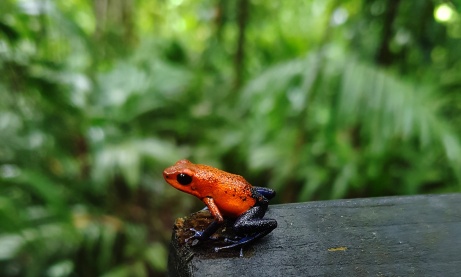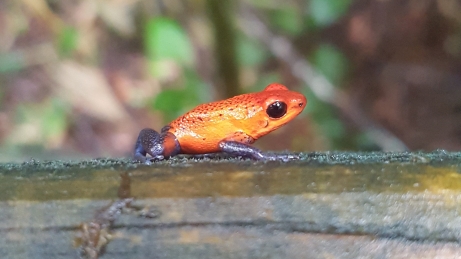I’m not a herpetologist or even a biologist, my day job is in media and communications. However, through my work of documenting life in the field, I have fallen in love with the most subtly charismatic creatures of the rainforest, poison dart frogs. The danger that such a small and beautiful creature can produce fascinates me and I have been lucky enough to witness these toxic gems in their true home, the primary forests of Central America. So far, I have only seen two species, the strawberry poison dart frog [of the “Blue genes” colour morph] and the green and black poison dart frog. Both are classified as least concern by ICUN, but they are still being affected by legal and illegal deforestation throughout Central America. Even now, after seeing hundreds of the little amphibians, I get so excited when someone shouts that they’ve spotted one that I try to get as close as possible without the frog doing what it does best and hopping away.

Usually, when something is poisonous, your automatic reaction is to run in the opposite direction, but not with these guys. I’m captivated by their vivid colours, quirky behaviour, and miniature size. But, before I tell you why, you need to know a little bit more about them. The poison “dart” frog, which is also called the poison “arrow” frog, is named as such because they were commonly used by indigenous tribes in Central and South America to make fatal darts for hunting. This is made possible by the deadly toxins that they secrete from a gland under their skin. The toxin produced is an alkaloid poison, which can cause paralysis and death. The toxin surprisingly isn’t produced by the frogs themselves, but rather it is acquired from their diet. Scientists believed for many years that frogs mainly gained the toxin from eating ants which are known to be alkaloid producers. However, a study by Ralph Saporito found that frogs in the lowlands of Panama and Costa Rica obtained much of their Alkaloid poison by eating a diet consisting of oribatid mites as well as ants. In the study, Saporito’s team found that at least half of the alkaloids in the mites were also present in the strawberry poison dart frogs. Their colourful skin is a warning to predators that they are poisonous, another study published in 2001 by Kyle Summers found that there was a strong correlation between the brightness of the frog’s skin and how toxic the poison was.
 You can read and research all you want on an animal, but nothing beats actually seeing them in the wild. One day, when I was in search of a very different animal while waiting to cross a river, I spotted some little ruby coloured dots in the undergrowth. As I got closer, I realised they were not insects, like I thought, they were strawberry poison dart frogs. It wasn’t the first time I had seen these beautiful, dichromatic creatures, but my reaction was still just as delighted. The more I looked, the more it became clear this was a popular spot for them: they seemed to be on every tree. Luckily it was going to be a while before I could cross the river, so I took full advantage of this frog haven. I bounded over to a tree were this little blue jeans frog, no more than 2cm in length, carried a tadpole on its back, up a tree into a bromeliad. This was the first time I had witnessed this behaviour. I had always just assumed all frogs acted the same towards their offspring and were essentially absent parents. I had no idea that poison dart frogs were such tentative parents, carrying each tiny tadpole all the way up a tree into safe pockets of water.
You can read and research all you want on an animal, but nothing beats actually seeing them in the wild. One day, when I was in search of a very different animal while waiting to cross a river, I spotted some little ruby coloured dots in the undergrowth. As I got closer, I realised they were not insects, like I thought, they were strawberry poison dart frogs. It wasn’t the first time I had seen these beautiful, dichromatic creatures, but my reaction was still just as delighted. The more I looked, the more it became clear this was a popular spot for them: they seemed to be on every tree. Luckily it was going to be a while before I could cross the river, so I took full advantage of this frog haven. I bounded over to a tree were this little blue jeans frog, no more than 2cm in length, carried a tadpole on its back, up a tree into a bromeliad. This was the first time I had witnessed this behaviour. I had always just assumed all frogs acted the same towards their offspring and were essentially absent parents. I had no idea that poison dart frogs were such tentative parents, carrying each tiny tadpole all the way up a tree into safe pockets of water.
I was fortunate to capture a second trip up the tree in a video, you can just about see the tiny tadpole wriggling, held in place by a thick mucus that covers the parents back. As it turns out, carrying the tadpole to higher, safer ground isn’t the only fascinating fact about the parent and tadpole relationship, the mother will revisit each pool of water where her offspring was safely placed and lay unfertilized eggs for the tadpoles to eat. This feeding habit is the reasons why these tadpoles are poisonous despite not having eaten any ants or mites yet, the eggs given by their mother also contain toxic alkaloids.
Isn’t that just incredible? So, why poison dart frogs? Well, apart from all the amazing things I just told you, for me, they are the realisation of my new life living in the tropics. When I was a child I would dream about the rainforest and all the creatures that could possibly live in such a wondrous place. I vividly remember seeing poison dart frogs on a school trip. We were inside an amphibian and reptile enclosure, it was dark, humid and it had a strange smell I had never encountered before. The atmosphere already had me captivated, and as I was peering into all the glass boxes embedded into the fake rock, I came across these little colourful frogs. I’d never seen such brightly coloured frogs before. Dark greens and browns (as is common in Europe), yes, but not red, blue and bright green. I instantly needed to know more, and just like all curious 8-year-olds, rather than reading the plaque next to it, I pestered and bombarded the teacher with a thousand questions. That’s when I found out they came from the rainforest. A match made in heaven. I could only ever dream of being able to visit a place that could be home to such beautiful yet deadly creatures. Eventually, after a brief detour down a very much different path, that dream became my reality. But I didn’t just visit the rainforest, I decided to live there.

So even now, every time I see my little ruby, amphibian friends hopping around on the forest floor, a sense of overwhelming nostalgia and childhood curiosity floods my entire being. They remind me of how far I’ve come and how lucky I am to be able to witness such animals in their natural habitat; that I should always stay curious; and to ask as many questions as I can. Ultimately they remind me that there is so much more to the world than we can even begin to imagine.
In short, I love poison dart frogs because they are awesome.


Lovely story Meg. The Poison Dart Frogs look awesome. What a privilege to see them close up in the wild.
LikeLike